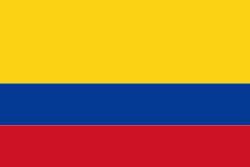Medellín
 |
 |
In 1616, the Spaniard Francisco Herrera Campuzano erected a small indigenous village ("poblado") known as "Saint Lawrence of Aburrá" (San Lorenzo de Aburrá), located in the present-day El Poblado commune. On 2 November 1675, the queen consort Mariana of Austria founded the "Town of Our Lady of Candelaria of Medellín" (Villa de Nuestra Señora de la Candelaria de Medellín) in the Aná region, which today corresponds to the center of the city (east-central zone) and first describes the region as "Medellín". In 1826, the city was named the capital of the Department of Antioquia by the National Congress of the nascent Republic of Gran Colombia, comprising present-day Colombia, Venezuela, Ecuador, and Panama. After Colombia won its independence from Spain, Medellín became the capital of the Federal State of Antioquia until 1888, with the proclamation of the Colombian Constitution of 1886. During the 19th century, Medellín was a dynamic commercial center, first exporting gold, then producing and exporting coffee.
Towards the end of the 20th century, into the beginning of the 21st the city regained industrial dynamism, with the construction of the Medellín Metro commuter rail, liberalized development policies, improved security and improved education. Researchers at the Overseas Development Institute have lauded the city as a pioneer of a post-Washington consensus "local development state" model of economic development. The city is promoted internationally as a tourist destination and is considered a global city type "Gamma +" by the Globalization and World Cities Research Network. The Medellín Metropolitan Area produces 67% of the Department of Antioquia's GDP and 11% of the economy of Colombia. Medellín is important to the region for its universities, academies, commerce, industry, science, health services, flower-growing, and festivals.
In February 2013, the Urban Land Institute chose Medellín as the most innovative city in the world due to its recent advances in politics, education, and social development. In the same year, Medellín won the Verónica Rudge Urbanism Award conferred by Harvard University to the Urban Development Enterprise, mainly due to the North-Western Integral Development Project in the city. In September 2013, the United Nations ratified Colombia's petition to host UN-Habitat's 7th World Urban Forum in Medellín, from 5–11 April 2014. In 2016, Medellín won the Lee Kuan Yew World City Prize. The award seeks to recognize and celebrate efforts in furthering innovation in urban solutions and sustainable urban development.
The valley and its Spanish settlement have gone by several names over the years, including Aburrá de los Yamesíes, "Valley of Saint Bartholomew", "Saint Lawrence of Aburrá", "Saint Lawrence of Aná", Villa de la Candelaria de Medellín, and finally "Medellín".
The name "Medellín" comes from Medellín, Spain, a small village in the Badajoz province of Extremadura. The village is known for being the birthplace of Hernán Cortés. The Spanish Medellín, in turn, was originally called "Metellinum" and was named after the Roman General Quintus Caecilius Metellus Pius in 75 BC who founded the village as a military base.
Some of the Conquistadors, such as Gaspar de Rodas, the first governor of Antioquia, came from the region of Badajoz. Count Pedro Portocarrero y Luna, President of the Council for the West Indies (Consejo de Indias), asked the Spanish monarchy to give the name of his town, Medellín in Extremadura, to the new settlement in America. His request was accepted on November 22, 1674, when the Regent Mariana of Austria proclaimed the city's name to be Villa de Nuestra Señora de Medellín. Miguel Aguinaga y Mendiogoitia, Governor, made the name official on November 2, 1675. The Crown granted a coat of arms to the city on June 24, 1676.
Map - Medellín
Map
Country - Colombia
Currency / Language
| ISO | Currency | Symbol | Significant figures |
|---|---|---|---|
| COP | Colombian peso | $ | 2 |
| ISO | Language |
|---|---|
| ES | Spanish language |


















